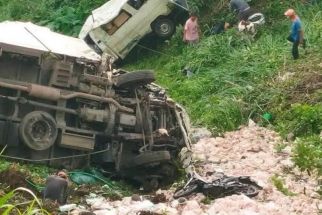Overloaded trucks banned on MNR, too
February 11, 2006 | 12:00am
SAN FERNANDO, Pampanga — Operators and drivers of overloaded trucks will not find the old Manila North Road (MNR) an alternative to the North Luzon Expressway, (NLEX) where they are banned due to weight limits, even if its P1.6-billion upgrading is completed this year.
Ramon Aquino, Central Luzon director of the Department of Public Works and Highways (DPWH), told The STAR that he is meeting with the Philippine National Police, the Land Transportation Office and other law enforcement agencies on Feb. 14 to make sure that Republic Act 8794, which limits vehicle loads to a maximum of 13.5 tons per axle, is strictly implemented along the old MNR.
Aquino said about 81 percent of the MNR, often erroneously referred to as MacArthur Highway, has already been upgraded under Phase 1 of the DPWH’s P500-million rehabilitation program.
The upgraded portions extend from Marilao, Bulacan to Tarlac City.
"We don’t want overloaded trucks to damage it prematurely. Besides, it is high time the law against overloading is strictly implemented for public safety," Aquino said.
He said the upgraded highway complies with international standards.
He cited a recent study showing that of 410 trucks weighed recently along the MNR, 98.29 percent were overloaded.
The other day, traffic got snarled for nearly five hours when some 300 trailer trucks blocked the area near the NLEX tollgate in Caloocan City to protest the anti-overloading policy of the Manila North Tollways Corp. (MNTC).
The truckers lifted the blockade only after police officials appealed to them.
Aquino, however, said truck owners would not encounter any problems if only they would use the proper trailer for heavy loads.
"The more the wheels that share the burden of the load, the lower would be the weight per axle," he said.
He said flatbed trucks fitted with more wheels can carry a load of as much as 38 tons without violating the maximum limit of 13.5 tons per axle.
"Such a flatbed truck could have a weight of 5.2 tons on the front wheels, and 8.1 tons each on the third to fourth wheels, so none of the axles would even reach the maximum of 13.5 tons per axle," he said.
On the other hand, a smaller truck with less wheels but loaded with only 17 tons could reflect 2.4 tons on the front wheels and as much as 13.6 tons on the rear wheels which would exceed the 13.5-ton maximum, he added.
"It’s just like an object being carried by people. The more people there are helping carry the object, the less weight each person would experience," he said.
With the strict implementation of the law against vehicle overloading, Aquino said truck owners are left with two alternatives.
"The short-term alternative is for them to lessen the load of their trucks. The long-term one is for them to upgrade their trucks so that they could carry heavy loads without violating the maximum weight per axle," he said.
Aquino said only four kilometers of the upgraded MNR need to be concreted.
Phase 2, to be started this year, would consist of upgrading 25 bridges, costing a total of P600 million which is included in the 2006 proposed budget.
He said these bridges include those along the MNR in Meycauayan and Labang in Calumpit, both in Bulacan, and Tiaong and Dalakitan in Sto. Tomas, Pampanga, which have been closed to heavy vehicles due to deterioration.
"But after these bridges have been replaced, overloaded trucks will not be allowed to use them," Aquino said.
Marlene Ochoa, MNTC director for corporate communications, said the company will not yield to the truckers’ demand to shelve its maximum weight rule along the NLEX, adding that "to ignore the weight limit is to break the law."
"Apart from breaking the law (and prematurely deteriorating the expressway), we would be putting the safety of other motorists on the NLEX in jeopardy if we allow overloaded trucks," she said.
The MNTC has portable weighing scales deployed randomly at entry points. Trucks found overloaded are escorted to the nearest exit, while their drivers are issued violation tickets and their driver’s licenses confiscated.
Department of Transportation and Communications Undersecretary for Land Transport Ricardo Alfonso defended the MNTC policy against overloaded trucks, saying their operators have been warned since last year.
Ramon Aquino, Central Luzon director of the Department of Public Works and Highways (DPWH), told The STAR that he is meeting with the Philippine National Police, the Land Transportation Office and other law enforcement agencies on Feb. 14 to make sure that Republic Act 8794, which limits vehicle loads to a maximum of 13.5 tons per axle, is strictly implemented along the old MNR.
Aquino said about 81 percent of the MNR, often erroneously referred to as MacArthur Highway, has already been upgraded under Phase 1 of the DPWH’s P500-million rehabilitation program.
The upgraded portions extend from Marilao, Bulacan to Tarlac City.
"We don’t want overloaded trucks to damage it prematurely. Besides, it is high time the law against overloading is strictly implemented for public safety," Aquino said.
He said the upgraded highway complies with international standards.
He cited a recent study showing that of 410 trucks weighed recently along the MNR, 98.29 percent were overloaded.
The other day, traffic got snarled for nearly five hours when some 300 trailer trucks blocked the area near the NLEX tollgate in Caloocan City to protest the anti-overloading policy of the Manila North Tollways Corp. (MNTC).
The truckers lifted the blockade only after police officials appealed to them.
Aquino, however, said truck owners would not encounter any problems if only they would use the proper trailer for heavy loads.
"The more the wheels that share the burden of the load, the lower would be the weight per axle," he said.
He said flatbed trucks fitted with more wheels can carry a load of as much as 38 tons without violating the maximum limit of 13.5 tons per axle.
"Such a flatbed truck could have a weight of 5.2 tons on the front wheels, and 8.1 tons each on the third to fourth wheels, so none of the axles would even reach the maximum of 13.5 tons per axle," he said.
On the other hand, a smaller truck with less wheels but loaded with only 17 tons could reflect 2.4 tons on the front wheels and as much as 13.6 tons on the rear wheels which would exceed the 13.5-ton maximum, he added.
"It’s just like an object being carried by people. The more people there are helping carry the object, the less weight each person would experience," he said.
With the strict implementation of the law against vehicle overloading, Aquino said truck owners are left with two alternatives.
"The short-term alternative is for them to lessen the load of their trucks. The long-term one is for them to upgrade their trucks so that they could carry heavy loads without violating the maximum weight per axle," he said.
Aquino said only four kilometers of the upgraded MNR need to be concreted.
Phase 2, to be started this year, would consist of upgrading 25 bridges, costing a total of P600 million which is included in the 2006 proposed budget.
He said these bridges include those along the MNR in Meycauayan and Labang in Calumpit, both in Bulacan, and Tiaong and Dalakitan in Sto. Tomas, Pampanga, which have been closed to heavy vehicles due to deterioration.
"But after these bridges have been replaced, overloaded trucks will not be allowed to use them," Aquino said.
Marlene Ochoa, MNTC director for corporate communications, said the company will not yield to the truckers’ demand to shelve its maximum weight rule along the NLEX, adding that "to ignore the weight limit is to break the law."
"Apart from breaking the law (and prematurely deteriorating the expressway), we would be putting the safety of other motorists on the NLEX in jeopardy if we allow overloaded trucks," she said.
The MNTC has portable weighing scales deployed randomly at entry points. Trucks found overloaded are escorted to the nearest exit, while their drivers are issued violation tickets and their driver’s licenses confiscated.
Department of Transportation and Communications Undersecretary for Land Transport Ricardo Alfonso defended the MNTC policy against overloaded trucks, saying their operators have been warned since last year.
BrandSpace Articles
<
>
- Latest
- Trending
Trending
Latest
Trending
Latest
Recommended































